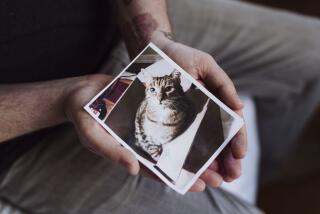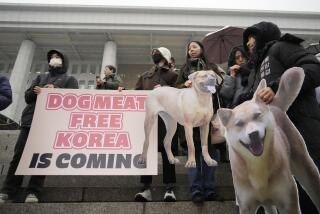Once a Menu Item, Dogs Now Beloved by Hong Kong Families
- Share via
HONG KONG — As a child, Wai Ka-wing used to enjoy a meal of dog meat, and it was a luxury--costing twice a much as beef or pork.
Now, he has a pet Shih Tzu that sleeps beside him, and his deep affection for Fifi keeps him from even thinking about eating dogs.
“We used to have them in our dishes, but now they are part of our family,” the 53-year-old retired firefighter says. “It’s so awful to see them die.”
When Fifi eventually does die, Wai may take advantage of a growing service in Hong Kong--the cremation of pets whose ashes are stored in urns so they can be remembered like human ancestors.
“This is a good service,” says Kwok Siu-cheong, a diamond designer who just cremated Bobby, his dog of 21 years, whose death left Kwok weeping for weeks.
As Hong Kong’s people became richer and better educated over recent decades, many former dog eaters have converted to pet lovers, creating a growing business for pet shops and services.
Years ago, pet owners had little option but to put dog and cat carcasses in landfills, still Hong Kong’s most common canine and feline resting places, the Environment Protection Department says.
Chan Kwok-kee, 40, suspects the remains of the Persian cats he bred had it even worse.
Chan buried them--illegally--in Hong Kong’s countryside in the Sai Kung district before he emigrated to Canada in the early 1990s. He was shocked when he came back later and saw three-story buildings on top of the graves. He suspects the cats were mixed with slurry to become house foundations.
The loss inspired Chan to start cremating animals in 1996. He’s now helped hundreds of pet owners bid a more dignified farewell to cats, dogs, hens, tortoises and lizards.
Chan carries a pager to stay on call 24 hours a day and collects animal carcasses immediately when he receives calls from pet owners.
Chan keeps the animals refrigerated until he burns the bodies and any toys, clothes and biscuits the pet had. Crushing it all into ashes and placing them in a silk bag, he then gives the owner an urn labeled with the pet’s portrait and name.
Some owners keep the urns in Chan’s office, where he has several cabinets full. Others take them home.
Business has been growing and Chan says he and several competitors cremate about 400 pets a month.
He says it’s something he could not have imagined as a child when Hong Kong Chinese were not so affectionate about dogs and cats.
Although the government banned killing dogs in 1950, many Hong Kong people used to eat dog meat every winter--believing it kept them warm and kept their stomachs healthy. Meat from a black dog was best of all, tradition holding that it could drive away evil spirits.
As dogs have moved closer to the hearts of people in Hong Kong, there has been explosive growth in the veterinary industry, from less than 10 practitioners 20 years ago to more than 100 these days, says Dr. David Burrows, senior veterinary officer at the Agriculture, Fisheries and Conservation Department.
Realizing the growth in pets will lead to a growth in mourning when the animals die, the government plans to open a crematorium for animal carcasses by 2004. The Society for the Prevention of Cruelty to Animals plans an animal park with cremation services and a garden for remembrance.
“There is a general awakening toward environmental and humane issues,” says Christopher Hanselman, the society’s executive director.
That’s not the only reason behind the new place for cats and dogs.
“What’s significant now is that many couples decide not have children,” says Maggie Ng, chief editor of My Pet magazine. “They opt to have pets as children, and to release their parental love, they call them ‘son’ and ‘daughter.’ ”
More to Read
Sign up for Essential California
The most important California stories and recommendations in your inbox every morning.
You may occasionally receive promotional content from the Los Angeles Times.













